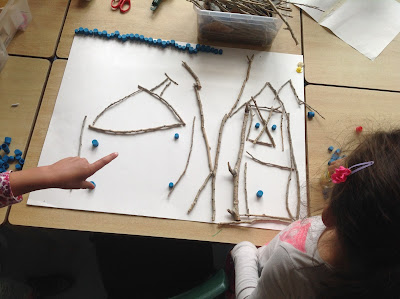The process of creativity is not one in which children have to dedicate themselves to through persistence and hard work. When materials are present and accessible to children you will see acts of radical genius emerge.
Vea Vecchi, Children, Art, and Artists
From the presentation by Brianne Bongiovanni
www.bambinicreativi.com
I was fortunate to capture the starting of a wonderful creative piece between two girls (S. T. and L. B.) during our Thinking and Learning Time. As I walked by I noticed they were using crayons to create pictures. Placing them point to point horizontally, vertically, and diagonally. I found it interesting that they used crayons and manipulated them in such a manner to create in a very different way than they were intended.
I asked them what they were doing and they told me they were making a house and shapes with crayons.
"I think I made this with crayons when I was a baby. I wanted to show L. B." S. T.
I decided to ask them if they wanted some bristle board paper so they can create on that using some of the Art Studio materials. They were very excited about this! I was surprised how quickly they planned out their collaborative creation. No glue was used, they simply placed their pieces on the paper and kept adding more detail by placing the materials in different ways. Their dialogue was very minimal. As I observed them work, they seemed to agree on what the art work was going to be, but then each started creating on their side of the paper. Watching them gave me visions of dancers perfecting their choreography. Each piece placed had a purpose and complimented the art piece.
I asked them how they got the idea to create this?
"Yea, we were just playing with crayons and then you saw it and got us paper. We thinked about it in our head." L. B.
"The blue things are windows. This one here is what turns the door." L. B.
Over the few days that it took them to finish their collaborative art piece, they purposely selected and added new materials, providing more detail to their work.
Some students became intrigued and asked if they could do this too? They were always welcomed by the two girls, but again, there was no dialogue as to what they could or couldn't do. They joined the dance by watching what others were doing, getting a sense of what the creation was all about.
The more I observed them work, the more I realized that this piece was not about the right or wrong way to place the materials but rather about the collaboration, inclusiveness, and peer support that this art piece provided to all students who joined in.
As new students flowed in and out creating small sections of the art work, the two girls remained constants, continuing their work until completion.
I supported their work by suggesting that if they wanted to preserve it, they could use glue to stick the materials onto the paper. It was their choice.
I'm sure you wonder what the explanation for this collaborative art piece is? I asked the two girls this question.
"It's very noisy in the city. There's lots of people, it's very sunny and the sky is everywhere. there's pretty flowers and people like to go to places like the grocery store." L. B.
"This is my house and this is L. B.'s house. There's a butterfly and the green things are flowers. We have a lot of things in our city. We worked together because we know how to do cities and towns." S. T.
What are intelligent materials?
- Highlights children's thoughts and ideas, as opposed to focusing on the actual material
- Have multiple uses, sometimes even infinite possibilities
- Provoking
- Can be used in any space in the classroom or school
- Support student's learning and thinking
www.bambinicreativi.com
Questions to ponder:
What learning do you see having taken place in creating this art piece?
How can one create an environment that encourages children to feel confident and safe to express themselves creatively?
How can one support children who are new to working and creating with open ended materials?






















Very interesting work! I find it fascinating that one child described a "noisy" city and I'm wondering if the "busy" arrangement of her work represents noise in her/his thinking? Thinking about sound being represented using 3d materials challenges our interpretations of materials.
ReplyDeleteThank you for the comment Ellen. Very thought provoking. When this child made the comment I found it interesting that she was able to reference sound using the materials used. I also interpreted the business of the materials to represent noise. Perhaps I can engage them in a dialogue to explain how they know the city is noisy?
ReplyDeleteMaybe when they create some sounds in their play you could save (tape) them and ask them to "build" them with materials you offer. Would be interesting to notice how they represent high/low, loud/soft, short/long and of course - emotions. Fun!
ReplyDeleteThank you! A wonderful suggestion! It would be very interesting indeed!
ReplyDeleteAnamaria, thanks so much for sharing this very special blog involving Lizzie. We were so happy to read about this project and discuss it with her...we're so proud of her work with Sophie!
ReplyDeleteAlthough I love all of your blog posts, I found this one particularly touching with how inclusive, collaborative and determined the girls were. If they've learned these skills by age 4-5, it will set them up well for life!
ReplyDeleteTotally stunning! :D
ReplyDeleteLove your blog, Anamaria.